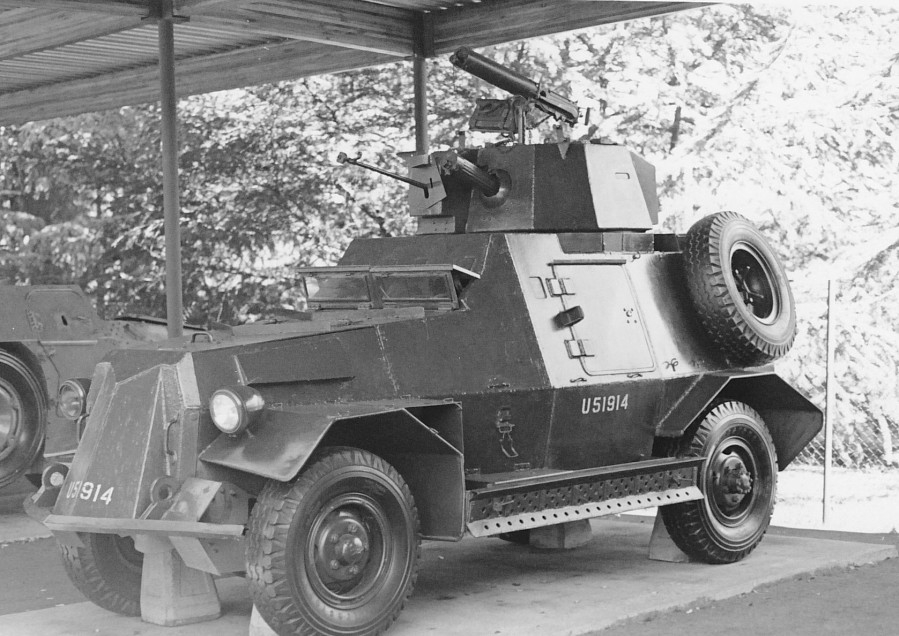Overview
Hello fellow Warthunderers! Today’s suggestion is the Marmon-Herrington Mk.III Armored Car, a vehicle that just barely fits the requirements to be added into the game, serving in the British/South African Army across Africa, and seeing action in WWII.
Basic Information
Designation: Mk.III
Role: Armored Reconnaissance Car
Crew: 3
Manufacturer: Marmon-Herrington Company
Total built: 2,630
Time Built: 1941-1942
Specifications
Dimensions:
-
Length: 17 ft (5.18 m)
-
Width: 6.56 ft (2 m)
-
Height: 8.76 ft (2.67 m)
Driving Performance:
-
Engine(s): Ford V8 liquid-cooled gasoline engine (95 hp)
-
Transmission: Manual 4/1 w/2 spd-tmsf
-
Suspension: 4x4 independent leaf springs w. axle steering
-
Max Speed: 55 mph (88.5 km/h)
-
Range: 300 mi (322 km)
Armor:
-
Front: 0.47 in (12 mm)
-
Sides: 0.24 in (6 mm)
Armament:
-
Primary: 1x .55 cal (14 mm) Boys Anti-Tank Rifle
-
Coaxial: 1x .303 (7.62 mm) Vickers Machine Gun
-
Additional: 1x .303 (7.62 mm) Vickers Machine Gun (Pintle-Mounted)
Usage in Battles
The Mk.III would be an interesting low-rank or starter vehicle, requiring a fair bit of skill to use effectively, seeing as its primary armament can just barely pen armor, it will heavily rely on flanking maneuvers and ambushing opponents, taking advantage of its fantastic speeds to out-pace its opponents.
Pros:
-
Fantastic Manueverability
-
Rapid reload rate for follow-up shots
-
Smaller profile makes it harder to hit
Cons:
-
Extremely poor survivability due to armour
-
Often Ineffective AT-Gun
-
Low weight mean obstacles can stop the vehicle
History
The Marmon-Herrington Mk.III was designed as early as 1940, being the most produced variant of the Marmon-Herrington family. It was essentially an enhanced version of the Mk.II, with a slightly shortened wheelbase for more agility, modified sloped armor, though unchanged thickness, and fitted with a more powerful Ford engine.
The new turret was bigger than the original Mk.II, being octagonal with a rear turret basket, having a two piece front for Boys AT rifle protruding from one and a MG port from the other. The turret had two small side slits and a two-piece hatch. The armored body was of welded construction and the tires were self-sealing.
Production was assumed in the same way like the previous models, with the four-wheel drive train and transmission from Marmon-Herrington in the USA, the chassis and engine supplied by Ford Canada, and armament supplied by the British. Assembly was then performed locally by the Dorman Long Structural Steel Company for the armored body and the Ford Motor Company of South Africa for the final assembly, fittings and its delivery. Production started in May 1941, and halted in August 1942. By then, 1780 Mk.III MFFs had been delivered, and several variants/modifications produced. The production was halted in the summer of 1942 because the Mk. III had shown limitations both in protection and armament.
The Marmon-Herrington Mk.III had better manueverability than its predecessor, but had the same protection issues. The armament was light and the Boys AT rifle could not be compared to AT guns like the 2-pounder. They were still assigned to reconnaissance units and saw skirmishes with anything they encountered, sometimes well behind enemy lines, due to their already long range being supplemented by extra spare parts and fuel cans. While it may have been considered sub-par, a handful of historical documents and photographs show that many Mk. III vehicles were rearmed with captured guns like the German Flak 38 20 mm (0.79 in) or Breda 20 mm (0.79 in) guns, inside a modified turret.
British West African forces operated 60 Mk.IIIs, the Free French had 10 Mk.IIIs in Central Africa, and outside Africa, 255 were used in India, and 175 in Malaya, Mozambique and Rhodesia. By 1943 these vehicles were gradually being phased out and were kept for training or rear-guard patrols in Africa. For the Royal Dutch Indies army, or KNIL, 49 were purchased in 1941 and arrived just before the Japanese landed on Java. They were in poor condition and lacked any armament. After some time the KNIL managed to have 27 of the 49 operational, in those were assigned into two independent recon platoons, the 1st and 2nd based at Bandoeng. The Greeks also operated a small number of Mk.IIIs just prior to the German invasion in May 1941.
Additional Photos
https://tank-afv.com/ww2/south_africa/photos/marmon_mk3_indiantroops_credits-aviarmor.jpg
https://tank-afv.com/ww2/south_africa/photos/Marmon-Herrington-III_Singapore_1941.jpg
https://www.quartermastersection.com/british/afvs/img/MarmonHerringtonMkIII.jpg
https://war-book.ru/wp-content/uploads/2019/02/00027912.jpg
https://www.o5m6.de/western/img/wd_ArmCars_Marmon%20Armoured%20Car%20Mk.II_17.jpg
Sources
Marmon-Herrington Armoured Car - Wikipedia
Marmon-Herrington Mk. III (1941)
MARMON HERRINGTON ARMOURED CAR Mk. III - Quartermaster Section
http://warfare.gq/Marmon-Herrington/index.html?i=1
https://www.wealdfoundation.org/collection/south-african-reconnaissance-car-herrington-mk-iii-early/
- Yes
- No






